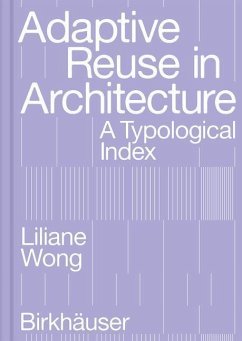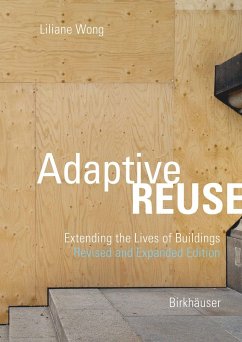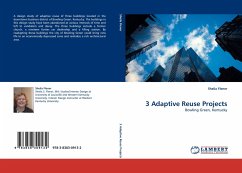Nicht lieferbar

Int AR Interventions and Adaptive Reuse
Resilience and Adaptability
Herausgegeben: Berger, Markus; Wong, Liliane; Rhode Island School of Design
Versandkostenfrei!
Nicht lieferbar
Design interventions for the reuse of existing structures must face the question of the past and the extent to which it should be included in the design for the future. This is the point of departure of Int AR, a yearly publication on current issues in international adaptive reuse.The 21st century has witnessed a climate of crisis, most often immediate and unpredictable but, at times, foreseen, impending and even expected. Such events and the ability for continuity, recovery and change, require strength borne from adaptability. This volume explores the idea of resilience, from anticipatory strategies to shock absorption, from the reduction of material needs to the widening of the array of resources, from the liberation of traditional constraints to new forms of collaborations, from built-in redundancies to risk mitigation. The examples range from places of resilience in post-industrial cities and in the suburbs of Paris to the rebuilding of post-war Beirut and different resilient approaches to Italy’s and Japan’s earthquake experience. Linking the theoretical concept of resilience to the planning practice of adaptive reuse, the volume demonstrates the interdisciplinary usefulness of this concept in the design disciplines.
Entwurfliche Eingriffe in bestehende Bauten stehen immer vor der Frage nach der Gegenwart der Vergangenheit: Wie soll das Alte im Neuen aufscheinen? Dies ist der Ausgangspunkt von IntAR, einer jährlichen Publikation zu aktuellen Fragen von Umbau und Umnutzung in den Entwurfsdisziplinen. Das 21. Jahrhundert zeigt sich als eine Zeit der Krisen, meist unberechenbar, doch in manchen Fällen vorhersehbar und sogar erwartet. Um auf Krisenereignisse mit Kontinuität, Stabilisierung und Wandel reagieren zu können, ist die Kraft der Anpassungsfähigkeit verlangt. Dieser Band ist dem Konzept der Resilienz gewidmet: von antizipatorischen Strategien bis zur Schockdämpfung, vom minimierten Materialeinsatz bis zur Ressourcenerweiterung, von vorgesehenen Redundanzen bis zur Risikominderung. Die dargestellten Beispiele reichen von Orten der Resilienz in postindustriellen Städten und in den Pariser Vorstädten über den Wiederaufbau des kriegszerstörten Beirut hin zu unterschiedlichen resilienten Reaktionen auf Erdbeben in Italien und Japan. Der Nutzen des theoretischen Konzepts der Resilienz für die Entwurfsdisziplinen erweist sich hier in seiner Verbindung mit der Planungspraxis des Bauens im Bestand.







